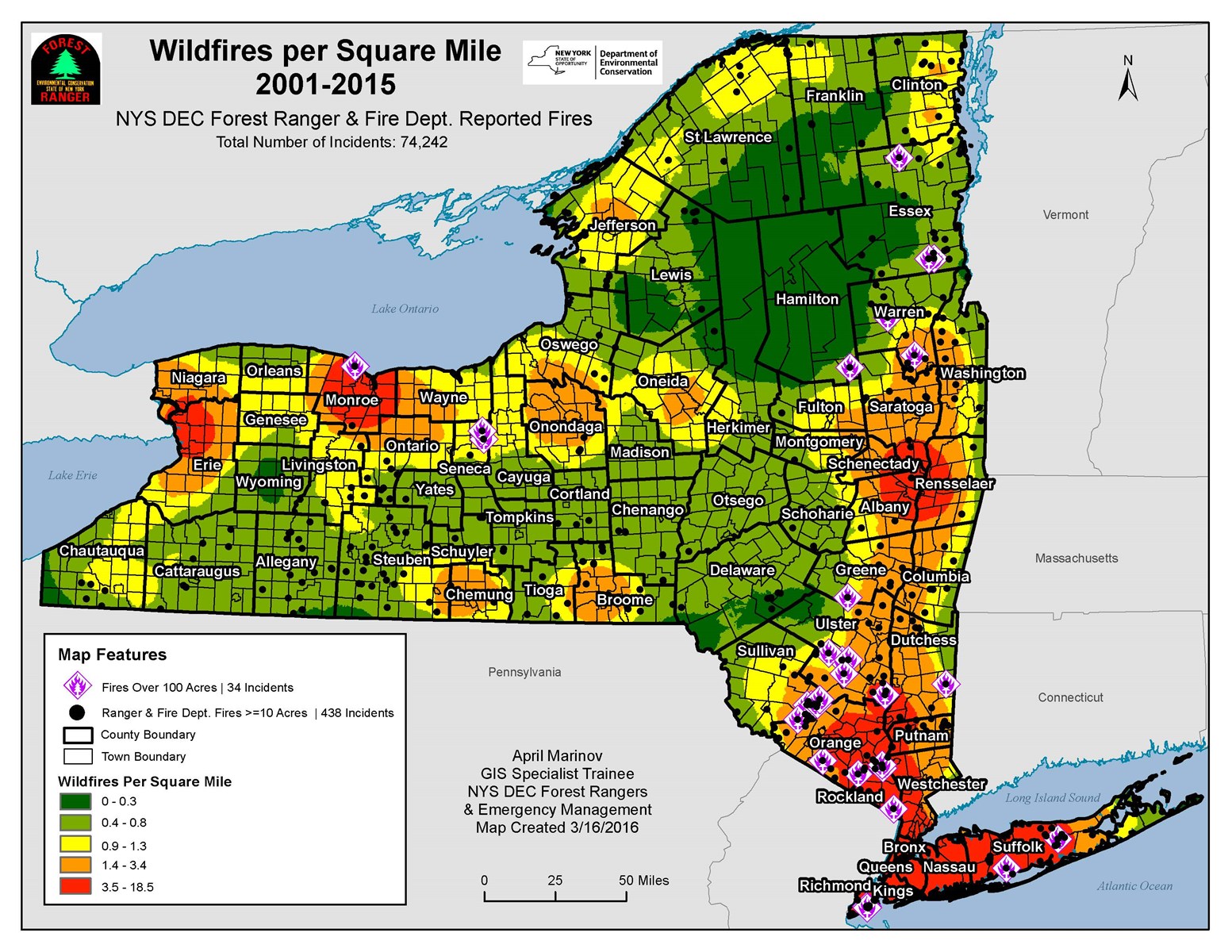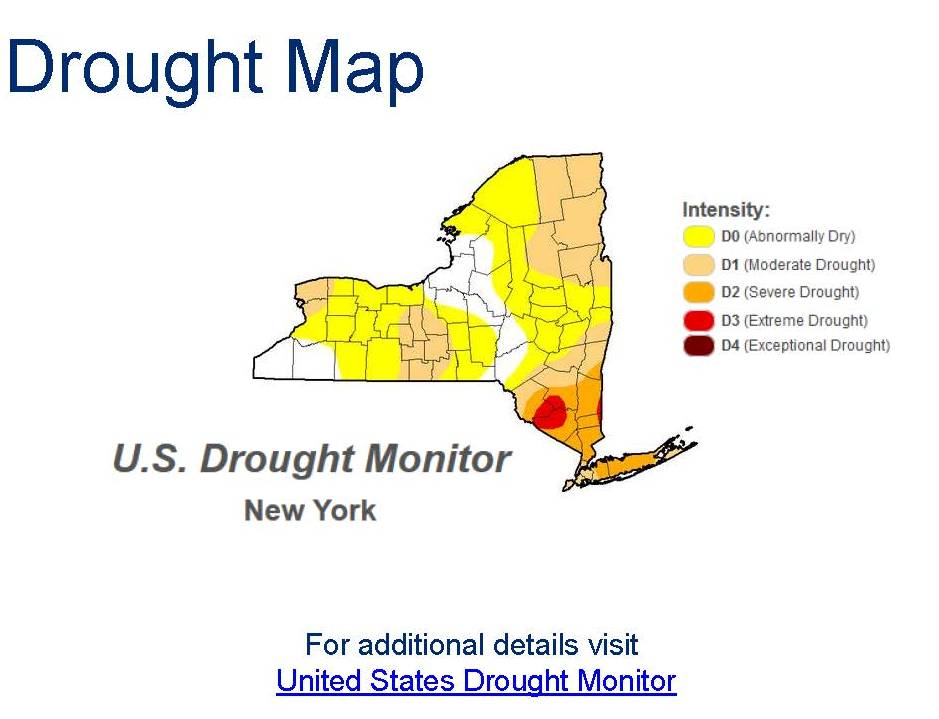The Central Pine Barrens Region contains extensive fire-dependent ecosystems that require fire to maintain forest health and regenerate. Though wildfire is a natural process in the fire-adapted Central Pine Barrens, years of fire suppression have led to a large build-up of vegetation on public forest lands, creating potentially hazardous wildfire conditions.


As a result, the region contains a number of communities currently at risk of wildfire, which are also ranked by New York State as among those at greatest threat from a wildfire. This situation is compounded by the tremendous population growth within Suffolk County in recent decades, growth that has led to the construction of more homes and businesses in areas susceptible to wildfire. Increased population has increased wildfire concern since the majority of wildfires in the region result from human action.
Development continues to increase deep into, and adjacent to, wooded and natural areas thereby creating a Wildland Urban Interface (WUI), the area in which development and undeveloped wildland meet. It is at this intersection where wildfires have their greatest impact on people.
Climate change is another concern. The impact of climate change has extended the length of the fire season on Long Island and elsewhere in the Northeast, as weather conditions have become more extreme. Temperatures are expected to increase by 5° F by 2100 and changes in precipitation patterns may result in the Northeast area experiencing a 10-20% increase in the risk of wildfire.1 With Long Island already in a severe drought, as indicated in the graph on this page, the risk of wildfire is elevated and this limits the ability of fire management professionals to perform certain fuel mitigation measures, such as prescribed fire, on public lands (prescribed fires must be performed within specific weather condition limits and other parameters to ensure proper control).
F by 2100 and changes in precipitation patterns may result in the Northeast area experiencing a 10-20% increase in the risk of wildfire.1 With Long Island already in a severe drought, as indicated in the graph on this page, the risk of wildfire is elevated and this limits the ability of fire management professionals to perform certain fuel mitigation measures, such as prescribed fire, on public lands (prescribed fires must be performed within specific weather condition limits and other parameters to ensure proper control).
Damage to the Central Pine Barrens forest has occurred from the spread of pests such as gypsy moths and the Southern Pine Beetle. These pests, along with diseases and past wildfires, have impacted wildlife habitats and caused the accumulation of significant event fuels in need of mitigation to reduce wildfire intensity (event fuels are natural, flammable materials, such as dead trees, branches, leaves and detritus, which accumulate in considerable quantities due to the occurrence of an event such as a tree disease or insect outbreak or wind storms).
More than 800 brush fires typically occur every year during the spring and summer months in Suffolk County. In 1995, the Rocky Point and Sunrise Fires burned more than 5,000 acres and continued to burn for several days. These wildfires resulted in extensive evacuations, property loss and damage, the closure of major transportation routes in the area and significant economic impacts to local businesses, tourism and residents.
After the 1995 wildfires, the Central Pine Barrens Joint Planning and Policy Commission created the Wildfire Task Force, a consortium of wildfire experts, to provide guidance and advice regarding wildfire prevention and response. (The Wildfire Task Force is referenced under the “Wildfire Management” section of this website.) In order to provide more consistent management of wildfires and pre-fire activities, the Wildfire Task Force developed a Fire Management Plan that was completed in 1999 that is available in our online document library.
One key component of the Fire Management Plan that has already been implemented was the purchase, installation and operation of a fire weather station that, along with fire danger signs placed along main roads and near park entrances, help notify fire management professionals and the general public about current fire danger levels, which note how difficult it would be to control a wildfire based on modeling programs that evaluate regional weather conditions and vegetation. This is part of the fire danger rating program.
In April of 2012 the Crescent Bow wildfires in the Ridge and Manorville areas burned more than 1,200 acres, which resulted in evacuations of homes and significant damage to property and natural resources. In the wake of the April 2012 Crescent Bow Fire, the Commission developed a multi-pronged strategy to deal with the on-going wildfire threat. The strategy includes:
- Providing increased and enhanced training for volunteer firefighters and first responders via the Commission’s Wildfire and Incident Management Academy
- Expanding the use of prescribed fire to reduce wildfire fuel loads
- Reinvigorating and updating the Central Pine Barrens Fire Management Plan and the implementation of its recommendations
- Expanding the establishment of Firewise Communities programs and
- Supporting the enhancement of water supply resources for wildfire fighting efforts
Public education and awareness of wildfire prevention is extremely important to reduce wildfire occurrence in the Central Pine Barrens, since, as noted above, the majority of wildfires are caused by people. The Commission, through its Wildfire Task Force, carries out various wildfire prevention initiatives that are referenced under the "Wildfire Management" section of this website.
Continued community-level wildfire planning initiatives, such as the Ridge-Calverton-Community Wildfire Protection Plan (CWPP), help to bring local communities and public land managers together to address wildfire concerns and help homeowners take responsibility for their own home’s protection by implementing measures to reduce the impact of wildfire. A fire-adapted community accepts fire as part of the natural landscape and understands its fire risk. It takes action before a wildfire occurs to minimize harm to residents, homes, businesses and other community assets to create a safer living environment. A copy of the RMCCWPP is available in our online document library.
The Commission looks forward to completing additional CWPPs for other areas in the Central Pine Barrens in the near future. Communities that have these plans in place can apply for federal funding to help them implement their plan’s wildfire mitigation strategies to make their community safer and fire-adapted.
To learn more about fire management in the Central Pine Barrens and to obtain copies of Commission-related fire management plans, visit our online document library and select the category "wildfire management".
Please feel free to contact firemanagement@pb.state.ny.us with any questions.
1. The Nature Conservancy, Global Climate Change, “Climate Change Impacts in New York, A Summary of the threats that climate change poses to the people, businesses and ecosystem of New York”, dated 9/2006.